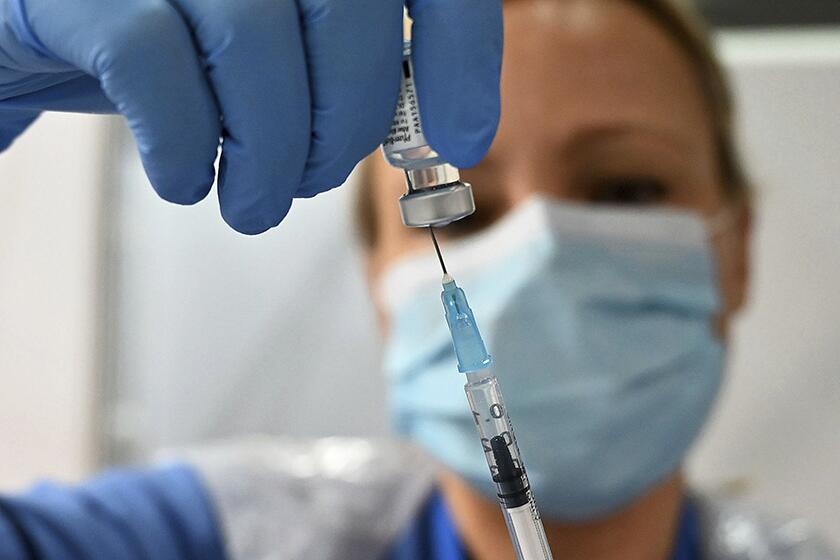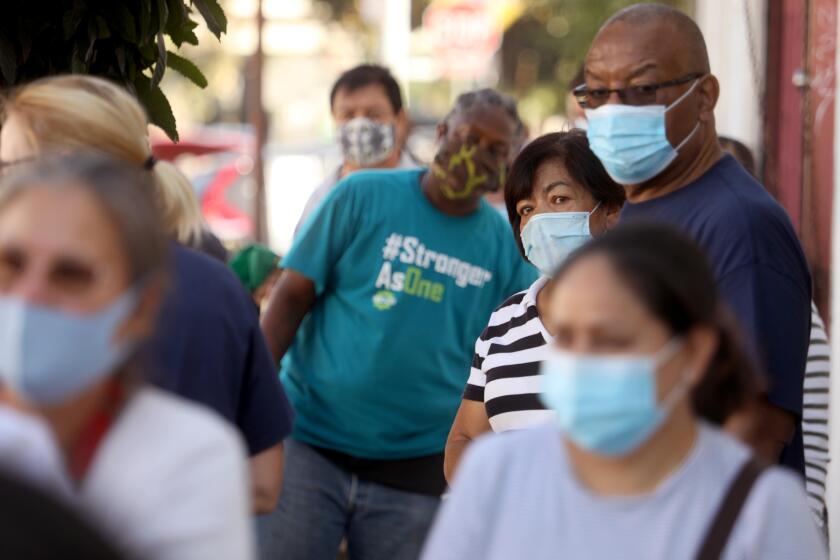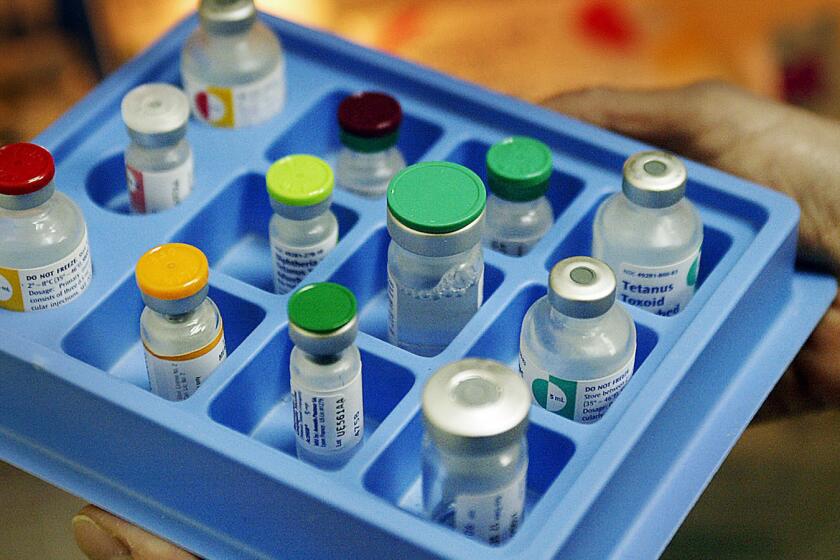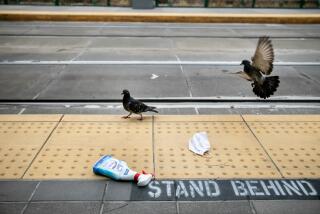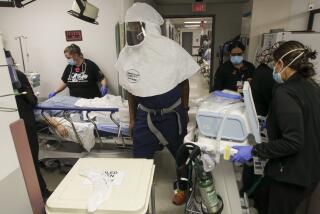Editorial: COVID treatment must be rationed according to need, not age, social rank or longevity
- Share via
(Editor’s note: Los Angeles County hospitals are so overwhelmed with COVID-19 patients that they are developing triage plans to determine whom to treat and whom to let die. The Times wrote in April about this nightmare scenario, and the right way — and the many wrong ways — to ration emergency treatment. Here is that editorial.)
“Our society faces momentous decisions,” the chief of surgery explained to a young resident. “About terminal illness, prolonged coma, transplantation. Decisions about life and death. But society isn’t deciding. Congress isn’t deciding. The courts aren’t deciding. Religion isn’t deciding. Why? Because society is leaving it up to us, the experts. The doctors.”
The words are lines from a movie (“Coma,” 1978), and the chief of surgery was Richard Widmark, the resident Geneviève Bujold. But they have an eerie resonance today as physicians in communities overwhelmed by COVID-19 face momentous decisions over which critically ill patients should have access to life-saving ventilators and other scarce resources and which patients should be denied.
The most harrowing instances have been in the northern Italian region of Lombardy, where in February and March witnesses described hospital hallways filled with the sick and dying, and overwhelmed medical staff making unthinkable decisions about how to allocate the care that could save them.
Alarmed by Italy’s experience, many U.S. cities and states have gone into a virtual lockdown to slow the infection rate and spare their doctors the ethically fraught choices their Italian counterparts had to make. The idea is to “flatten the curve” — to spread the most urgent cases over a longer period of time and avoid masses of patients competing all at once for a finite supply of ventilators and medical specialists.
Enormously costly to livelihoods and liberty, the stay-at-home orders nevertheless appear to have succeeded in holding off the predicted flood of patients that threatened to overwhelm our capacity to treat them. Yet the danger is far from over. With no known treatment or vaccine for COVID-19, we may yet be hit by potentially worse waves of cases as the orders are lifted and we try to resume our pre-pandemic routines.
In fear of such surges, most states have drawn up crisis standards of care: special guidelines that in effect assign patients their places in line in the event medicals staffs here have to work through Lombardy-type quandaries.
Early rollout of the COVID-19 vaccine has been slow and confusing
Many, and perhaps most, of these protocols fail miserably. They neglect basic human values in favor of unconscionable ranking by economic and actuarial factors, and by even more insidious and less easily identifiable considerations.
The states that have moved in this troubling direction include California, which released SARS-CoV-2 Crisis Care Guidelines earlier this month after making a cursory effort to gather public input.
State officials had reached out to the trade groups representing doctors and hospitals, but advocates for seniors, the disabled and other people with a very urgent stake say they were not formally consulted. The state Department of Public Health quickly labeled its document a draft and began — appropriately, if quite late in the process — broader outreach in order to develop a more thoughtful set of guidelines.
The ultimate decision for crisis standards of care in California falls to each hospital. The actual decision on the front lines is made by doctors.
The department claims that it began planning for this crisis a decade ago, as did U.S. officials, in the wake of the H1N1 epidemic. Yet California and other states seem to be behind the curve in making recommendations for “triage,” the process of deciding whom to treat when resources are overtaxed.
Triage comes from the French verb trier, to sort, and long referred to a process of categorizing produce. In England it once meant a system of sorting coffee beans.
But on Napolean’s battlefields, medics used a triage system to prioritize care for the wounded by rank: High-ranking officers first, followed by their subordinates, and then soldiers with slight wounds who could be quickly patched up and sent back to the fight. Low-ranking soldiers with serious injuries were of no further use and were left on the field to die, even if their lives could have been saved with proper care.
Then a French surgeon named Dominique Jean Larrey reinvented triage by eliminating the primacy of military rank, as befits a man who had come of age during the revolutionary era of liberty, equality and fraternity. In Napolean’s Grande Armée, treatment was now to be prioritized by urgency of need. The most grievously injured personnel who could be saved were treated first, regardless of military status.
The rank-free, urgency-of-need approach suits the United States, where the revolutionary 18th century creed that all men are created equal has been repeatedly honed and perfected over nearly 250 years of struggle for civil rights and equal justice under law.
Coronavirus cases are surging in the U.S. There’s no vaccine yet. We can either mask up or lock down.
Yet rank of a sort keeps slipping back into the mix and is still used to prioritize medical care, even here, even now. Hospitals and physicians, in conjunction with state health departments, have crafted an array of factors to measure patients’ life spans and their economic or social value — and therefore their worthiness of treatment — when cataclysmic events cause more people to need lifesaving resources than are available. In anticipation of such emergencies — pandemics, for example — patients are rated by a variety of factors that are unrelated to their urgency of need or their chance, with treatment, of recovery.
In its draft, California is one of many states prepared to assign patients their place in line based on “life years” — an actuarial determination of how much longer the patient is likely to survive after recovery, whether it be from COVID-19, a grievous injury (from an earthquake, perhaps) or another life-threatening condition. Other states use quality adjusted life years — “QALY” — that modify the supposed value of the predicted life span by adding possible debilitating conditions to the equation.
Some quality-of-life determinations consider whether the coronavirus patient has a preexisting illness or “comorbidity” factor such as obesity, or a physical or intellectual disability. State guidelines in Washington recommend transferring patients with “loss of reserves of energy, physical ability, cognition and general health” to outpatient or palliative care.
Going a step further, some economists advocate prioritizing those who, on recovery, will contribute the most economic or intellectual value to the nation. Happily, no state has adopted such a policy — at least not explicitly.
The problem is that in the United States, and probably in most countries, the healthiest are by no coincidence also the wealthiest. The socially and economically privileged enjoy better medical care, and employment that challenges their intellect without breaking their bodies. Their social status is reflected in their income, and often in their life spans.
Who gets the short end of the American stick? The nation’s marginalized people — the poor, the disabled, people of color — are too often left with jobs that put them in harm’s way and pay them too little in return. Being in close contact with the sick, those workers then are more likely to contract contagious diseases such as COVID-19. They are more likely to have conditions such as diabetes or kidney disease that, on an actuarial chart, predict shorter life spans and reduced economic output.
That’s the bias inherent in care protocols that consider factors beyond whether treatment is likely to help the patient recover. If a ventilator could save you, but you have a shorter predicted life span because of your diabetes, your weight or some other condition brought on by your marginalized socioeconomic status, you may be directed to the back of the ventilator line. Actuarial tables and algorithms ostensibly meant to predict your likelihood of survival now instead determine it. That’s an injustice that corrodes American values of equality to an even greater degree than the temporary loss of liberty brought on by state and local shutdown orders.
The situation underscores a cynical but not altogether inaccurate observation: Civil society, ostensibly created to protect the weak from the powerful, often works the other way around. People and groups in power manage to create societies that perpetuate their privilege. They write the rules that allocate emergency care.
Thank goodness for the disabled community and its advocates, who through long experience fighting for human dignity have become experts at identifying policies and practices that would further marginalize communities too often shunted aside by American society.
The Disability Rights Education and Defense Fund and other organizations have filed complaints with the U.S. Department of Health and Human Services against Alabama, Tennessee, Utah, Pennsylvania, Washington and Kansas — but so far not California — over the crisis care triage protocols promulgated by those states in undue haste and with inadequate community consultation. The complaints zero in on the implied presumption that COVID-19 patients with physical or intellectual disabilities are less valuable, experience a lower quality of life and therefore are less worth saving, even if they would benefit from treatment.
Settlements have been reached in several states. Others remain in negotiations.
With coronavirus on the rampage, perhaps the people who don’t believe in vaccinations will rethink their irresponsible position.
Civil rights advocates argue as well on behalf of seniors, who likewise should not be sent to the back of the treatment line because of actuarial tables.
Age is properly considered as a factor in determining whether the patient will survive treatment. Ventilation, for example, is extremely hard on the body, and the death rate for seniors on ventilators is high. But that’s different from weighing the patient’s expected life span after he or she recovers from the virus.
Now wait, one might be tempted to argue: Does that mean an elderly person and a teenager in equal need of a ventilator must be given the same priority?
Even steadfast advocates for senior rights acknowledge being open to conversations about age as a “tie breaker,” for example in a situation in which three patients in apparently equal health, one aged 99, another 59 and another 19, each need the single available ventilator to survive.
A treatment guideline that respects basic American values (and, by the way, federal civil rights laws) that all human beings are created equal, and throughout their lives remain equal in dignity, will ask to what extent each patient is to benefit from the treatment. Not how much each patient might enhance the nation’s prosperity or knowledge and skills after recovery, nor how many years of remaining productive life are projected by actuarial tables, nor how many quality-of-life points he or she earns or loses by having other medical conditions or personal predicaments. Nor how many people love them or hate them, or how intensely; nor whether they are sports or entertainment superstars, or well-connected tycoons or politicos. The approach was laid out by Larrey at Waterloo: Limit the triage calculation to the current life-threatening condition, and disregard what kind of life the soldier, or the patient, might lead after recovery.
Most triage decisions will be made in the heat of battle, so to speak. Shouldn’t physicians be free to use their best medical judgment under the circumstances, without state protocols and guidelines?
Perhaps. But doctors are not superhuman. They do not necessarily react differently to crisis than do other people, except to the extent that they possess some extraordinary powers to do so.
The American Medical Assn.’s ethical code underscores the importance of separating the treating physician, who already is under great emotional stress, from decisions about whom to prioritize. The AMA calls for triage teams or officers to set guidelines. Larrey would likely have approved.
The American College of Surgeons argues against “triage practices that would discriminate against patients with disabilities, based on personal judgments of an individual’s functional limitations.” Life years saved are to be considered only “when decisions between two patients with equal chance of survival must be made.”
Essential, too, is the input of ethicists, philosophers, religious leaders and, most of all, by representatives of affected communities.
If most of humanity were about to be wiped out and we were looking to preserve a new Noah and family to repopulate the planet and reestablish civilization, then perhaps it might make sense to single out the smartest, the strongest, the most skilled or the most virile (or perhaps the most moral or the most reverent) to save. But the coronavirus, while devastating, is no ark situation. It is not an extinction event. It is no excuse for subverting the principle that rank should have no place in triage decisions.
Any healthcare rationing decision is going to be politically fraught, especially when the government is playing a role in the decision-making. The best approach is to ensure that emergency triage, and leaving some people to die in this pandemic, remains a hard-fought but strictly theoretical matter.
If we can’t do that by rapidly increasing our supply and distribution of medical equipment, emergency physicians and specialists, then we do it by holding down the surge. That’s why Americans can tolerate a temporary infringement on personal liberty. That’s why we stay at home instead of going to the movies or to the beach, and why owners of restaurants, bars and other retail businesses have closed their doors: to prevent hospitals from being overwhelmed by critically ill patients, and to not have to take a ventilator away from a patient whose life could be saved.
The economic and social costs are huge. But we pay them in order to reject the process of assigning a different value to different human beings, and to reject the affront to human dignity that such calculations entail.
More to Read
A cure for the common opinion
Get thought-provoking perspectives with our weekly newsletter.
You may occasionally receive promotional content from the Los Angeles Times.
